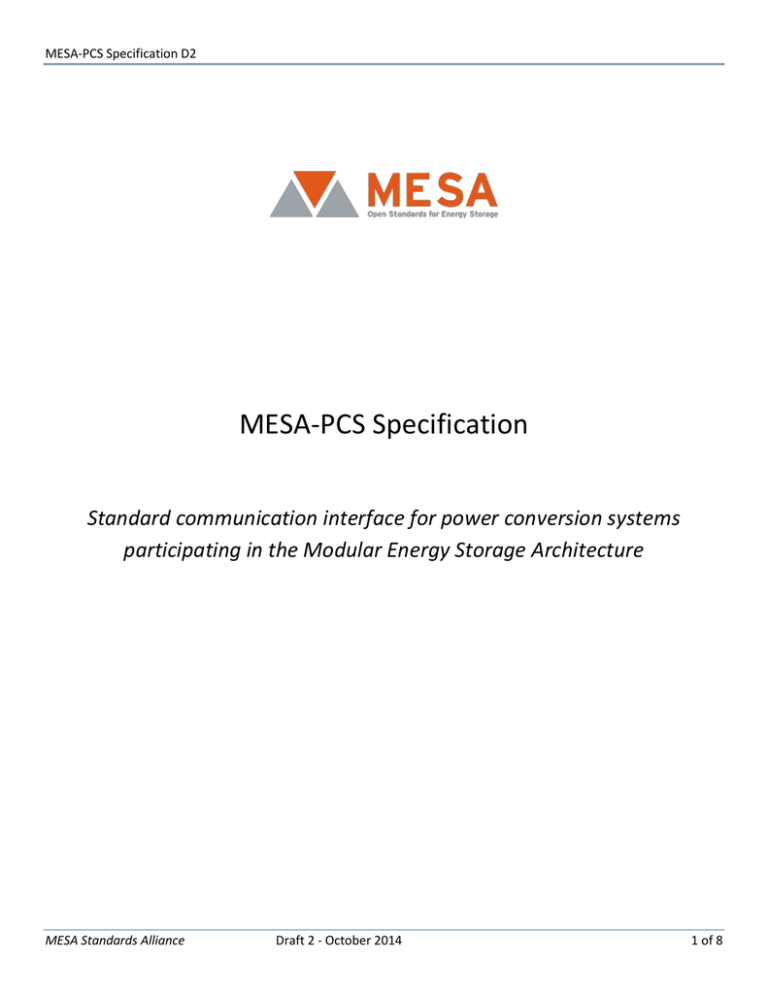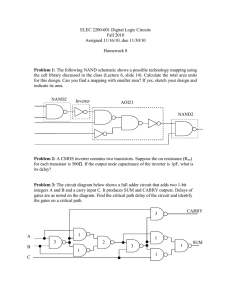
MESA-PCS Specification D2
MESA-PCS Specification
Standard communication interface for power conversion systems
participating in the Modular Energy Storage Architecture
MESA Standards Alliance
Draft 2 - October 2014
1 of 8
MESA-PCS Specification D2
MESA Standards Alliance
August 2014 DRAFT
2 of 8
MESA-PCS Specification D2
Copyright © 2014 MESA Standards Alliance. All Rights Reserved.
This document and the information contained herein is provided on an “AS IS” basis and the MESA
Standards Alliance DISCLAIMS ALL WARRANTIES, EXPRESS OR IMPLIED, INCLUDING BUT NOT LIMITED
TO ANY WARRANTY THAT THE USE OF THE INFORMATION HEREIN WILL NOT INFRINGE ANY
OWNERSHIP RIGHTS OR ANY IMPLIED WARRANTIES OF MERCHANTABILITY OR FITNESS FOR A
PARTICULAR PURPOSE.
This document may be used, copied, and furnished to others, without restrictions of any kind, provided
that this document itself may not be modified in any way, except as approved by the MESA Standards
Alliance.
MESA Standards Alliance
Draft 2 - October 2014
3 of 8
MESA-PCS Specification D2
1 Introduction
The MESA Alliance develops and promotes standard interfaces for communicating with the components that are used in
today’s energy storage systems. The collection of component interfaces is referred to as MESA-Device. MESA-Device is
composed of three different sub-components:
MESA-PCS: A standard interface for power conversion systems.
MESA-Storage: A standard interface for batteries and other storage technologies.
MESA-Meter: A standard interface for power meters.
Working closely with the SunSpec Alliance, the MESA Standards Alliance has developed these interfaces for use by
component manufacturers. They have been designed to work together in the safe and efficient operation of a standalone energy storage systems.
This specification describes MESA-PCS: A standard communication interface for power conversion systems participating
in the Modular Energy Storage Architecture. Information on the other MESA-Device interfaces can be found on the
MESA web site: www.mesastandards.org.
1.1 References
The documents listed in Table 1 are either explicitly or implicitly referenced herein.
Document
SunSpec Common Models
SunSpec Inverter Monitoring Models
SunSpec Inverter Controls Models
SunSpec Meter Models
Table 1: References
Purpose
Provides foundational information for all devices which implement
one or more of the SunSpec models.
Describes the inverter monitoring models and is an approved
SunSpec Alliance interoperability specification.
Describes the inverter control models and is an approved SunSpec
Alliance interoperability specification.
Describes the meter models and is an approved SunSpec Alliance
interoperability specification.
1.2 Energy Storage System Diagram
While there are certainly different ways to assemble energy storage systems, all ESSs contain a few key components: a
power conversion system, a storage device, one or more metering devices, and a control system of some kind. The
diagram shows how the MESA interfaces are used in communicating between the various devices.
MESA Standards Alliance
August 2014 DRAFT
4 of 8
MESA-PCS Specification D2
Energy Storage System
Controller
MESA-PCS
SunSpec Inverter Models
100 Series
MESA-Storage
SunSpec Energy Storage Models
800 Series
MESA-Meter
SunSpec Meter Models
200 Series
Power Conversion System
Energy Storage
Meters
Diagram 1: Energy Storage Systems and MESA
2 MESA-PCS
A MESA-compliant power conversion system is a PCS which provides a Modbus/TCP communication interface and which
implements a specific set of SunSpec models. Modbus has been selected as the base protocol given the large number of
power conversion systems and inverters in the market today which already provide a Modbus interface. TCP has been
selected as the transport given its ubiquity and flexibility.
2.1 SunSpec Inverter Models
All MESA-compliant power conversion systems are by definition SunSpec devices. This means that they must include the
Common Model at the top of their Modbus register map, and they must include the End Model at the end of their
register map. For more information on the Common Model and the End Model, please see the SunSpec Common
Models document referenced in Section 1.1.
Additionally, all MESA-compliant power conversion systems must implement a small number of SunSpec inverter
models. The SunSpec Alliance has published over 20 different inverter models, many of which apply directly to power
conversion systems used in stand-alone energy storage systems. Other models which don’t apply to energy storage
systems may be implemented by the PCS vendor (e.g. for other applications) but are not required by MESA.
Table 2 lists all of the existing SunSpec inverter models and identifies those that must be implemented by a MESAcompliant power conversion system.
MESA Standards Alliance
August 2014 DRAFT
5 of 8
MESA-PCS Specification D2
Table 2: SunSpec Inverter Models
Model ID
101
102
103
111
112
113
120
121
122
123
124
125
126
127
128
129
130
131
132
133
160
Description
Single Phase Inverter Model (Integer Based)
Split Phase Inverter Model (Integer Based)
3 Phase Inverter Model (Integer Based)
Single Phase Inverter Model (Float Based)
Split Phase Inverter Model (Float Based)
3-Phase Inverter Model (Float Based)
Inverter Controls Nameplate Ratings
Inverter Controls Basic Settings
Inverter Controls Measurement and Status
Inverter Controls Immediate Controls
Inverter Controls Basic Storage Controls
Inverter Controls Pricing Signal
Inverter Controls Static Volt-VAR Arrays
Inverter Controls Frequency Watt Control
Inverter Controls Dynamic Reactive Current
Inverter Controls LVRT Arrays
Inverter Controls HVRT Arrays
Inverter Controls Watt-Power Factor Arrays
Inverter Controls Voltage-Watt Arrays
Inverter Controls Basic Scheduling
Inverter Multiple Power Point Tracker (MPPT)
Required by
MESA-PCS
No
No
Yes
No
No
Yes
Yes
Yes
Yes
Yes
Yes
No
No
No
No
No
No
No
No
No
No
Note that only one of Model 103 and Model 113 needs to be implemented. These are effectively the same SunSpec
model, where 103 uses an integer-based representation, and 113 uses floats.
More information on the SunSpec inverter models can be found here:
http://www.sunspec.org/specifications
2.1.1 Inverter Model Enhancements
Because of the differences between the inverters used in PV installations and the power conversion systems typically
used in energy storage systems, a few minor additions/changes are required in the implementation of the models
shown in the table above. These enhancements are shown in Table 3.
MESA Standards Alliance
August 2014 DRAFT
6 of 8
MESA-PCS Specification D2
Table 3: Inverter Model Enhancements
Model
Number
103/113
Register
Additions/Changes
Operating State (St)
In addition to the eight operating states listed in the SunSpec Inverter (Three
Phase) model, an additional ninth state shall be implemented:
9: Started
103/113
Event1 (Evt1)
This additional state indicates that the PCS has been properly initialized, that
the AC breaker and DC contractors are connected, and that the PCS is ready to
accept real and reactive power commands.
In addition to the 16 bits identified in the SunSpec Inverter (Three Phase)
model, two additional bits shall be implemented:
16: OTHER_ALARM
17: OTHER_WARNING
When OTHER_ALARM is set, it indicates that some other alarm has occurred in
the PCS (i.e. an alarm which does not map to one of the other alarm
categories).
123
WMaxLimPct
When OTHER_WARNING is set, it indicates that some other warning has
occurred in the PCS (i.e. a warning which does not map to one of the other
warning categories).
This register should be treated as a signed value since real power may be both
exported and imported. This is also consistent with VArMaxPct which is
treated as a signed value.
The MESA Standards Alliance has proposed the Inverter Model Enhancements listed in Table 3 to the SunSpec Alliance
Inverter Control Workgroup for review and approval and expect the enhancements to be incorporated in the next
revision of the SunSpec Inverter Control Models Specification.
2.2 MESA-PCS Extensions Model (V 64800)
In addition to the values and settings contained within the models listed in Section 2.1, testing with MESA partners has
shown that a small number of additional Modbus registers are required for safe and effective operation of the PCS.
These additional values and settings have been assembled into the MESA-PCS Extensions Model. The MESA-PCS
Extensions Model is a SunSpec vendor model with an ID of 64800.
As with the inverter model enhancements listed in Section 2.1.1, the MESA Standards Alliance is actively working with
SunSpec to push these additional registers into the official SunSpec models where possible.
The values and settings in the MESA-PCS Extensions Model are described in the subsections below.
2.2.1 Local vs. Remote Control
When maintenance is being performed on a PCS, remote control of the device should be prevented to ensure the safety
of the personnel performing the maintenance.
MESA Standards Alliance
August 2014 DRAFT
7 of 8
MESA-PCS Specification D2
The Control Mode value (LocRemCtl) in the MESA-PCS Extensions Model indicates whether or not remote control is
allowed. Under normal conditions, this value is 0 which indicates that remote control is allowed. If local maintenance is
required, on-site personnel will generally use a device-specific switch or HMI to put the PCS into local mode, at which
point Control Mode will return 1 and all remote commands will be refused. Once the maintenance operation is
complete, the same switch or HMI would be used to restore the ability to control the device remotely.
2.2.2 Heartbeats
When a PCS is asked to export or import power, it will generally continue doing so until a) it is asked to stop or b) the
energy source is exhausted. Should a communication error occur between the PCS and an upstream controller during a
charge or discharge operation, it is often not desirable to continue the export or import of power. It is important to be
able to detect these cases and respond accordingly.
The PCS Heartbeat value (PCSHb) in Model 64800 is an unsigned numeric value which is incremented every second on
the PCS. Periodically, this value resets to zero and the incrementing process continues (reset periodicity is up to the
device manufacturer). A controller or other master can use this changing value to confirm that the PCS is healthy and
able to provide updated values on demand. Should this heartbeat stop for any reason, a controller may assume that the
PCS is no longer in a healthy state, and take appropriate action (e.g. disconnecting the battery bank attached to the
PCS).
Similarly, the Controller Heartbeat value (ControllerHb) in Model 64800 can be used by the PCS to determine if it is
properly communicating with the controller. If this value is not updated every second as expected, a PCS may choose to
alter its state in some way, such as disabling the import or export of power.
It is worth noting that the use of these heartbeat values is optional.
2.2.3 Commands
The MESA-PCS Extensions Model provides two registers which may be used to control the PCS.
The Alarm Reset control setting (PCSAlarmReset) is used to request that the PCS attempt to reset any latched alarms. A
controller or other master who wishes to reset alarms on the PCS should set this register to one, which triggers the
action in the PCS. When the PCS is done resetting alarms (even if the resets were not successful), it should set the value
back to zero.
The Set Operation control setting (PCSSetOperation) is used start and stop the PCS, and also to move the PCS into or out
of standby mode. This setting is an enumerated value, and similar to Alarm Reset, once the operation is complete the
PCS should set the value back to zero.
2.2.4 Charge and Discharge Currents
As the state of charge in a battery bank rises and falls, the current limits for charging and discharging that battery vary.
A battery or other storage device may advertise these current limits using the SunSpec models described in the MESAStorage interface standard.
To ensure the safe and effective operation of the battery bank, a PCS generally needs to be aware of the instantaneous
current limits. The MESA-PCS Extensions Model exposes the Charge Current Limit (MaxBatACha) and Discharge Current
Limit (MaxBatADischa) settings for this reason. A controller or other master which reads current limits from the battery
bank should update these two values in Model 64800 to ensure that the PCS is aware of any updated limits on current.
The power conversion system, for its part, shall make every effort to honor the current limits provided to it.
MESA Standards Alliance
August 2014 DRAFT
8 of 8



